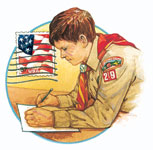
Letters
A TANGLED knot
I enjoyed your “Knots to Know” article in Outdoor Smarts [October 2007]. Adult leaders can’t teach Scout skills unless they know Scout skills.
However, I had trouble following the instructions for the Grapevine (Double Fisherman’s) Knot, which is subsequently needed for the Prusik, an important climbing knot that is also shown.
The instructions for the Grapevine Knot should explain that the knot is tied with two opposing double overhand knots, with an extra tuck after the first overhand turn in each.
Thanks for providing an enjoyable read.
Paul Quinn
Texarkana, Tex.
Many readers pointed out this discrepancy, as well as an error in the first photo of tying the taut-line hitch. A Web video showing how to tie the taut-line is located at: www.videos.sailingcourse.com/taut_wmv1.htm.
TWO TIMES THREE
 We enjoyed reading about Joshua Stone’s Hornaday projects. We know how tough it is to earn the Silver Hornaday Medal—we are the only two brothers in the country to both earn the Silver Hornaday Medal, be Eagle Scouts, and have earned all the available merit badges.
We enjoyed reading about Joshua Stone’s Hornaday projects. We know how tough it is to earn the Silver Hornaday Medal—we are the only two brothers in the country to both earn the Silver Hornaday Medal, be Eagle Scouts, and have earned all the available merit badges.
Earning the Hornaday medal was certainly one of the highlights of our Scouting career and taught us a lot about hard work and perseverance.
Kyle and Brady Baldwin
Fairfield, Calif.
Mazzuca is on target with YouTube
I read the interview with new BSA Chief Scout Executive Robert J. Mazzuca [October 2007] and wanted to comment on his emphasis of using technology to explore communication lines with today’s youth. He mentioned YouTube and MySpace in particular.
While not a fan of MySpace, I have used YouTube. I am a committee adviser for the Coosa Order of the Arrow (OA) Lodge of the Greater Alabama Council. The committee I advise is the audio/video/photo arm of the lodge.
We recently completed seven videos that help to promote the OA, and we have published them on YouTube at www.youtube.com/coosashows.
I think many OA lodges would be interested in our approach, and several across the nation have contacted us for permission to use the videos at their training events. We are happy to grant it.
Our mission is to use technology to further the purposes of the OA and our lodge and also teach youth how to use these tools. I was glad to see Mr. Mazzuca’s comments and concur with him!
David Murphree
Flat Rock, Ala.
Cool temperatures drain batteries
The “Take Better Pictures” article [October 2007] offered great tips. A clarification, however: Storing batteries in cool temperatures preserves their charge, though using batteries in cool temperatures drains them.
So the point of sleeping with batteries in your sleeping bag is to be ready to use them in the morning without waiting for them to warm up.
David Forthoffer
Eureka, Calif.
Mark Anderson, director of program at Philmont Scout Ranch responds: Batteries and many other items have a smell. If these are kept inside a tent, they might cause a hungry, curious bear to investigate, thus increasing the potential for a human encounter.
At Philmont Scout Ranch we stress the importance of carefully following all bear and wildlife procedures. Protecting the sleeping area from all smellables is an important part of these procedures.
In the winter, when bears are in hibernation, keeping batteries in a warm area might be possible. Otherwise, it’s important to remember that on a wilderness adventure, we must carefully follow all established procedures. By doing this we can reduce potential danger and help ensure a safe camping experience.
Pulling the plug on TV
 “Life After TV” [October 2007] is right on the mark. If we are interested in family
time, better grades in school,
and overall health (mental and physical), we must be less sedentary and solitary.
“Life After TV” [October 2007] is right on the mark. If we are interested in family
time, better grades in school,
and overall health (mental and physical), we must be less sedentary and solitary.
The Hattis family has it right and will not only benefit themselves but their community as well.
We hope all Scouts and their families will visit us at www.screentime.org and join our efforts for Turnoff Week 2008 (April 21-27) and find out how rewarding life can be without screens, or at least with less screen-time.
Robert Kesten, Executive Director
Center for SCREEN-TIME Awareness
Washington, D.C.
A cool article
I read with great interest Jean Dunning’s article “Scouting Is Cool” [November-December 2007]. What a marvelous article!
Ms. Dunning demonstrates great insight into human nature, and I believe her perceptions about the motives of our kids and the way she expresses them will be very helpful for Scout leaders across the nation. Good job; well done.
Timothy P. Malmquist
President, BSA Rainbow Council
Morris, Ill.
The value of the arts
Thank you for the excellent article “Introducing Children to Culture and the Arts” [Family Talk, October 2007].
As a longtime dance teacher and performer, merit badge counselor, and mom of an awesome Eagle Scout, it pleases me to see the BSA encourage boys to explore the arts as wonderful avenues for expression.
The Music and Art merit badges provide boys opportunities to discover gifts and talents they might not know they have. One of my most memorable teaching experiences was spending a week teaching high school football players ballet to improve their coordination, agility, and speed.
Field trips, particularly to high school plays and concerts, give Scouts a glimpse into this exciting world of culture. Invite your young musicians to perform at Eagle Scout courts of honor, Cub Scout blue and gold banquets, and even pack and troop meetings.
Along with academics, sports, and Scouting, the arts contribute to the making of well-rounded and confident young men.
Vicki Smith
Landenberg, Pa.
January - February 2008 Table of Contents
Copyright © 2008 by the Boy Scouts of America. All rights thereunder reserved; anything appearing in Scouting magazine or on its Web site may not be reprinted either wholly or in part without written permission. Because of freedom given authors, opinions may not reflect official concurrence.